The ASUS Pro WS X570-Ace Review: x8x8x8 with No RGB
by Gavin Bonshor on August 12, 2019 9:00 AM ESTBIOS
The ASUS Pro WS X570-Ace is using the more professional focused UEFI BIOS Utility with white and turquoise text on a black background. Its GUI and overall look are uniformed with two different modes available for users to select between; the EZ and advanced mode. This can be done by pressing the F7 key, with the advanced mode opening up a large selection of options for users to customize, including all of the overclocking sections available in the Ai Tweaker section.
Entering the firmware for the first time brings up the EZ mode which has a basic array of customizable options and provides easy access to some of the core functions of the BIOS. In the top left corner is a basic information panel which stretches down to the bottom which includes the motherboards model number, the firmware version being used, the processor installed including its core clock speed, and the amount of system memory including its current frequency. In the center are the current CPU temperature, the current CPU Core voltage and the motherboard temperature. Directly below this is a storage information panel which even lists USB flash drives which are installed into the rear panel USB ports. There's a CPU fan speed graph and below it is a Q-Fan Control utility. On the right-hand side is an EZ System Tuning profile selector and a Boot Priority order which users can click and drag to change the default booting order.
Accessing the Q-Fan Control utility can be done from both the EZ and Advanced modes of the firmware and allows users to customize the fan profile of individual fan headers, or selecting between the four pre-defined fan profiles. Each of the six fan headers can be individually controlled, or optimized in a group based on a look-up table within the firmware; the CPU fan and Opt CPU fan are linked together.
Within the Ai Tweaker section is all of the CPU and memory overclocking settings, as well as all the power-related options. There are options for altering the CPU Core frequency, base block frequency, and for users looking to make the use of AMD's Infinity Fabric, users can even alter this for better memory overclocking performance via the FCLK Frequency setting. Users may note that ASUS uses D.O.C.P and not the usual X.M.P memory overclocking profiles; these are the same thing and it's just the ASUS term for this. Along the right-hand side of the advanced mode is a hardware monitor which lists information such as CPU Core frequency, the base clock frequency, CPU Core Voltage, current CPU temperature, with current memory and voltage settings located below this. The maximum values for CPU Core Frequency, CPU VCore voltage, DRAM frequency and FCLK frequency are as follows:
- Maximum CPU Core Frequency = 6.375 GHz
- Maximum CPU VCore = 1.70 V
- Maximum DRAM Frequency = 6000 MHz
- Maximum Infinity Fabric/FCLK Frequency = 3000 MHz
We should point out that just because you can set these values, it doesn't mean the system will work.
As the ASUS Pro WS X570-Ace is targeting professional users, there are plenty of options in the firmware for networking support. The inclusion of the Realtek RTL8117 Gigabit NIC allows users to use the ASUS Control Center Express software which gives remote access and a variety of functions. Users can enable or disable this function, although its the only X570 motherboard to currently offer this feature.
The ASUS Pro WS X570-Ace officially supports ECC memory (not just in non-ECC mode) and as a result, the firmware is equipped with relevant options for scrubbing, linking, and memory addressing. The support for ECC memory comes down to whether or not the processor supports it and some motherboard models do allow ECC memory to be used, but this is the first model so far we've seen that officially supports ECC memory in ECC mode.
For professional users looking to create a remote accessible X570 based workstation, the ASUS Pro WS X570-Ace firmware seems equipped for the job. Not just for professional use, the overclocking options on offer are more than enough to eek every last MHz out of the processor and memory, with the inclusion of the networking and ECC memory options setting this model apart from the rest. The ASUS UEFI BIOS utility firmware itself feels very responsive, is stable, and is effectively laid out with plenty of settings for users to sink their teeth into.
Software
With all the focus being on its professional-level properties, the ASUS Pro WS X570-Ace doesn't encumber users with lots of irrelevant gaming-centric software, instead it focuses its attention on the ASUS Control Center Express application, and useful AI Suite 3 software.
The ASUS Control Center Express application is a watered-down version of its fully licenced professional ASUS Control Center software and offers users an entry-level point to server deployments, including VMWare. This works hand in hand with the Realtek RTL8117 Gigabit NIC and uses it as a controller and access point. Users can access the WS X570-Ace remotely through the RTL8117 NIC and also allows users to change BIOS settings, reset and switch the system off, as well as performance operating system installations across multiple clients.
Looking into the ASUS Ai Suite 3 software, users can overclock their processors with limited options available including CPU Core Voltage, CPU SoC Voltage, and CPU Core Frequency. For users looking for a more comprehensive overclocking tool, the Ryzen Master Overclocking utility works wonders, although overclocking from the firmware has always been, and always will be the recommended method from myself personally. Users can also use the EZ Update section to keep drivers and software up-to-date, although the ASUS Control Center Express application does need to be downloaded and installed separately from the ASUS website.
Even though there isn't much in the way of software to go through, the ASUS Control Center Express software is the pick of the bunch. Users looking to customize and tweak the Realtek ALC1200S HD audio codec are required to download the software from the Windows Store, which we have noted in numerous motherboard reviews this year.


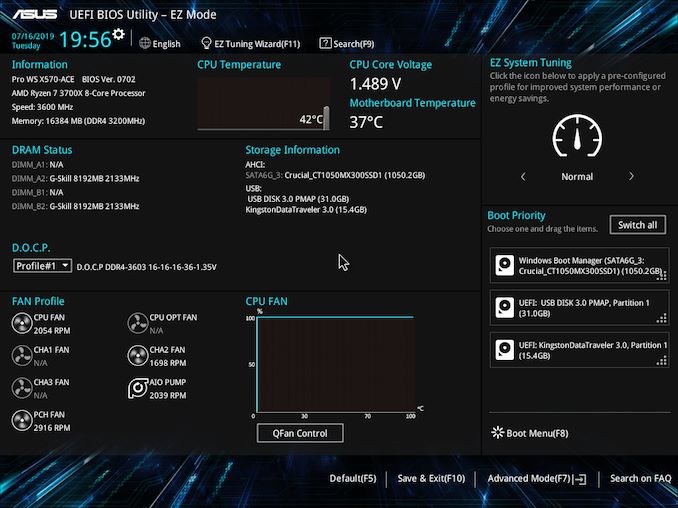
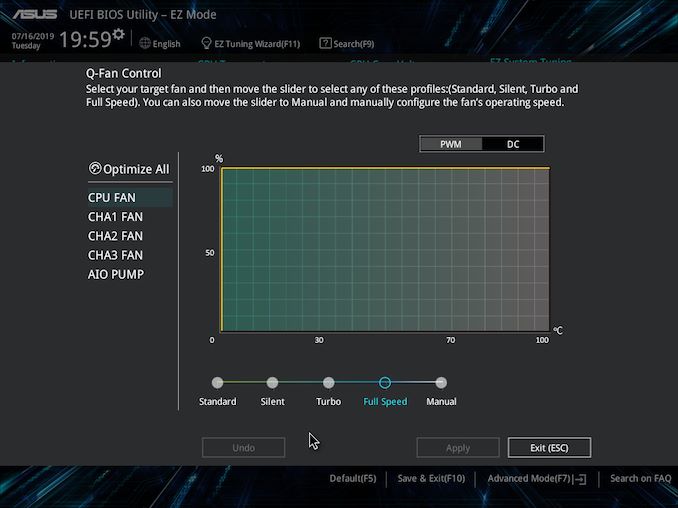
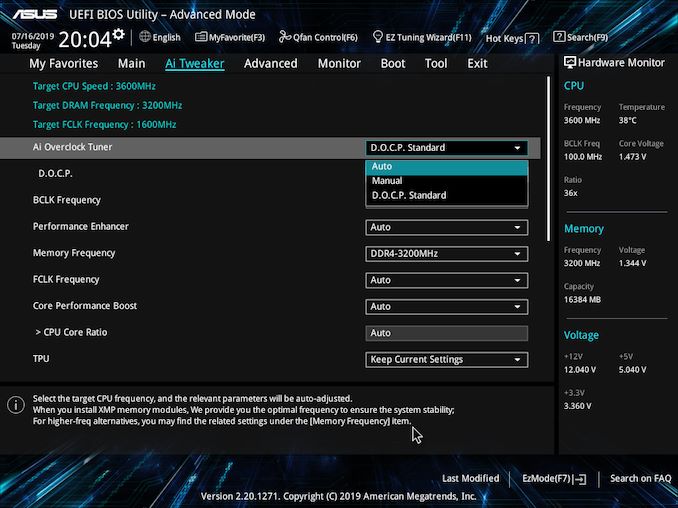
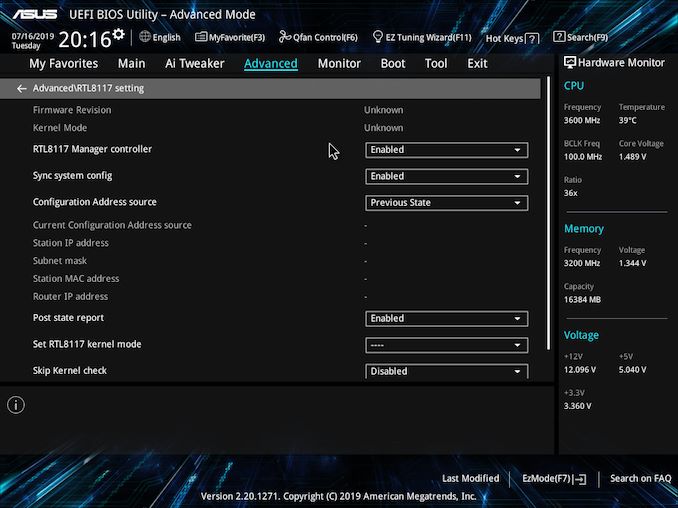
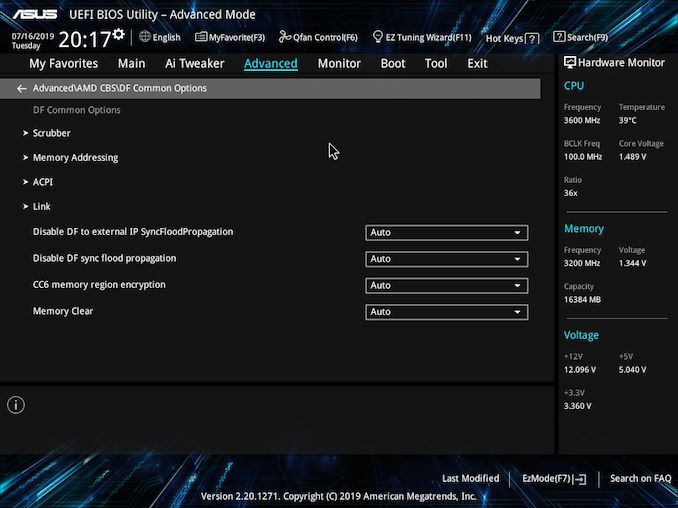






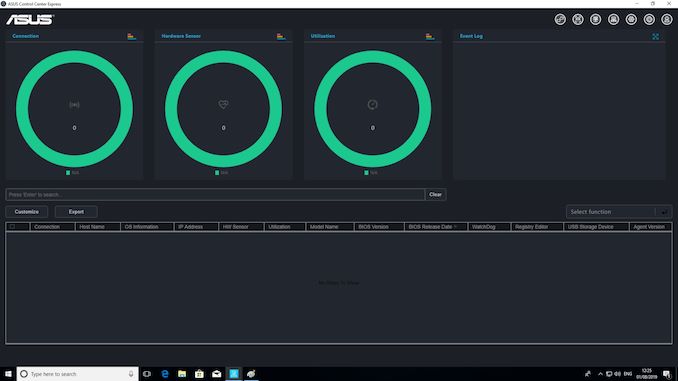
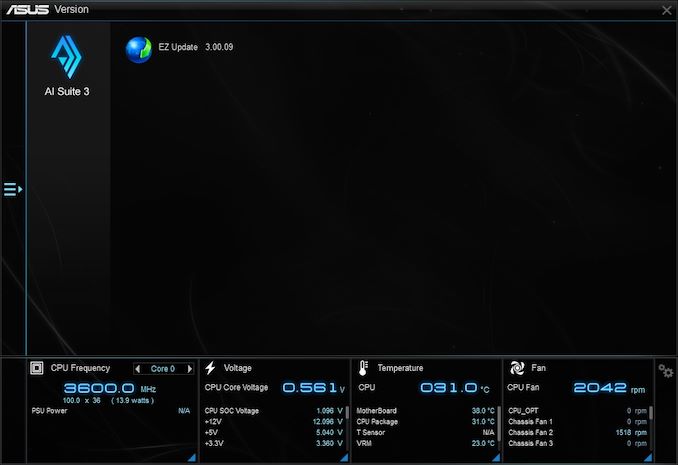














110 Comments
View All Comments
umano - Wednesday, August 14, 2019 - link
It seems a great mb and it has a wonderful look. It is not the board for me, I'd go HEDT with an Atx board, but I like the approach based on quality, caring about details that do not shine on paper or on images but they shine on performance, reliability and why not pleasure to use. The shield and separation for the audio it is a needed touch of design elegance.I really hope this is not the last we heard from x570 boards, to me the x570 offer lacks an outstanding pro oriented Itx board.
FredeBR - Wednesday, August 14, 2019 - link
I saw comments that 3900x works very hot (high temperature). On this asus board is it possible to configure processor downclock, like lowering the cpu voltage? I will use for full load processing for more than 24 hours in a row.TheinsanegamerN - Thursday, August 22, 2019 - link
The 3900x is a 12 core CPU. It's goona need some big boy cooling. If you dont want to deal with the heat you should probably stick with an 8 core ryzen. You could turn off turbo boost, but then why bother shelling out more for the big chips if youre just gonna kneecap it?abufrejoval - Thursday, August 15, 2019 - link
As much as I like the 3x8 general option, it pains me that the first logical addition to a GPU and perhaps a RAID controller, 10GBase-T Ethernet is going to swallow 8 lanes of PCIe 4, while a single lane would be quite sufficient and actually the Ethernet IP block for that is already supposed to be inside the 'chipset'! And that price, whatever licence cost required to make use of it, should be included.Otherwise it looks like one of the sanest mainboard designs I have seen so far.
alpha754293 - Thursday, August 15, 2019 - link
"One of the key elements to this board design is the x8/x8/x8 PCIe 4.0 slot layout. This motherboard is the only one on the market that uses a full PCIe 4.0 x8 lane available from the AMD X570 chipset, enabling an array of different use cases that ASUS believes this market needs. Technically the upstream link to the CPU is still limited to PCIe 4.0 x4, however this does enable PCIe 3.0 x8 cards to have full bandwidth, which accounts for a lot of add in cards (RAID, high-end networking)."This is quite possibly one of the worst boards on the market then.
They have three PCIe 4.0 x16 physical slots, but either only run at its native x16 speeds if you only have one card installed, x8 if you have two, and really x8/x8/**x4** if you have three cards installed since the chipset to CPU interface is a PCIe 4.0 **x4** link.
That is so dumb.
Why would they bother putting in a x16 physical slot, and then because of the chipset link, only run it at x4 electrically?
Quite possibly one of the worst product development/engineering decisions ever.
A single NVMe PCIe 4.0 x4 SSD would be able to consume all of that bandwidth.
moriz - Friday, August 16, 2019 - link
i think the key here is that the third slot can *supposedly run at PCIe **3.0** x8, which allows it to give full bandwidth to any PCIe 3.0 x8 add-in card.*supposedly, because i've yet to see any confirmation that it is capable of doing the PCIe version switch.
YaroslavZ - Sunday, August 18, 2019 - link
hey! , I bought this mobo a couple of days ago, I bought it because I wanted to upgrade my old cpu to R9 3900X, I also happened to have 4 R9 390 gpus (2 390s 2 390x) , sadly I don't have the cpu yet, I do have the r5 1400 lying around but I don't feel like taking it out from completely different cpu and adding it into that costly mobo just to test things out,I bought that mobo exactly to run 4way CFX with these gpus, 8x 8x 4+4x* & 4x from m.2 to pcie adapter,
based on your words, in theory the 3rd slot should be able to use more bandwidth than a simple 4x 3.0 , is that correct? if so then that will pretty good upgrade over a simple 4x.
anyways just to give you some info, a simple 4x 3.0 uses around 70~75% power of R9 390, while 8x around 99% ,
I do know that because atm i'm sitting through 8x 8x 4x in asus z170-a , which also have m.2 at x4 so 4way is possible as well but I bought the adapter just recently and I don't really want to sit through sata ssd, as well as this mobo currently have problems with 2 ram slots because of which I can't use dual channel atm, which obviously makes 3gpus to barely outperform a single gpu so adding 4th on top of that is pointless, wish the prices on r9 3900x will fall soon.
here is stock 3way (8x 8x 4x) 3dmark (firestrike ultra) score in dual channel when I still had it, also, R9 390X performing with stream processors of R9 390's if I got it right(aka it's like 3x of R9 390 even when some of them have X's), because I was forced to use R9 390 as gpu1 to enable CFX,, https://www.3dmark.com/fs/18192586
tristank - Tuesday, August 20, 2019 - link
How does this even works? Is there some kind of translation between PCIe 4.0 x4 to PCIe 3.0 x8. I dont get it. I thought this was not possible.JKJK - Friday, August 16, 2019 - link
A card like this without 10GbE is completely idiotic.You shouldn't have to waste a pci-e port on it. And it should be intel. Let the gamers use the unstable Aquantica shit chips and drivers (been there, done that).
Tomyknee - Sunday, September 1, 2019 - link
All I hear about is the chipset fan. I have read (Buildazoid in May 2019 Gig Master review) that it is the RAID setups going through the Chipset that sets the fan off. Unfortunately the second M.2 is only PCIe x2. Other than SATA drives maxed at 6gbs, it does not make sense to run RAIDO for speed. Samsung will have PCIe 4.0 NVMe M.2 that surpase 7gbs R/W within a year and the 2x will not take advantage of that.A deal breaker for me, (I really like this board, really want to order it - looks great and no RGB!)